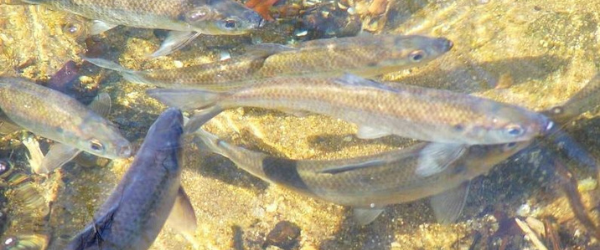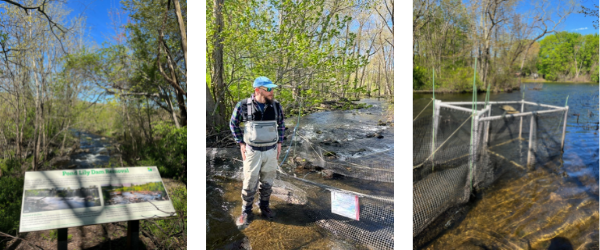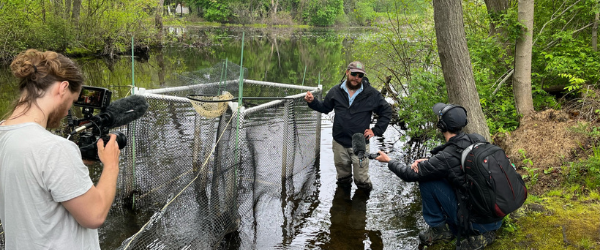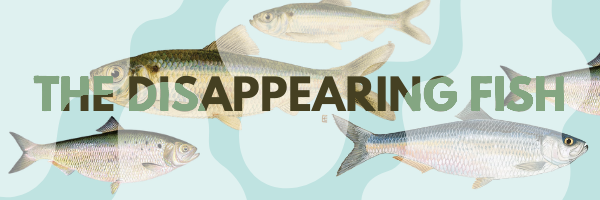You might think you’ve heard this one before — a story of the fish that got away.
But trust us, you haven’t.
Of course, that’s what every fish tale spinner would have you believe. They lure you with details of the setting, hook you with the stakes of the struggle, and then reel you in with the size of the prize. They season their saga with humanity and heroism, maybe a little heavy on the hyperbole. Still, you’ll swallow it whole, because deep down we all want these stories to be true.
The fish tale you’re about to read, though, is true. One hundred percent exaggeration-free.
And it has all those other elements. Everything you need for a proper fish tale. Everything, that is, except the fish.
The fish in our story didn’t get away. They never showed up to begin with.
Three hundred thousand alewife are missing.
That isn’t to suggest they’ve been misplaced. They’re just not there. Not anywhere they can be accounted for. Last spring, more than 400,000 alewife — the larger and more common of two local species of river herring — were surveyed by trap or camera in the state of Connecticut. So far this season, the number is closer to 100,000, a year-to-year drop-off of 75% that no one can yet explain. We can’t even be sure if there’s a problem that requires solving. Today, as we mark World Fish Migration Day 2022, just a few weeks from the end of the spring fish run, it seems the only thing missing in our story besides fish is an answer.

Alewife have gone missing before, but then we had a clear reason. It was 2015, and structures like the Pond Lily Dam on the West River in New Haven were impediments to migratory patterns of various fish species, including alewife, a diadromous fish that lives in the saltwater of Long Island Sound before heading up into freshwater to spawn. The numbers of alewife tracked annually on the West River were dangerously low, down to single digits, before Save the Sound administered an $800,000 project to remove Pond Lily Dam.
With the dam removed, the alewife population rebounded. Back in 2018, Save the Sound fish biologist Jon Vander Werff set up his first trap, provided by the state of Connecticut, a few miles upstream from the former dam site to begin tracking the return of alewife and other species. Jon improved on the original design, which would collapse in every storm. Now, his customized funnel trap is a chute, constructed from a horticulture mesh called Vexar, that feeds fish into a pen. It looks like a makeshift amphibious playpen tucked into the eastern bank of the West River as it takes a sharp left turn into Konold’s Pond.

Jon and his team check the trap six mornings a week, recording water temperature, flow rate, the amount of debris in the trap, and, of course, the number of each species of fish in the trap. They keep a careful eye out for alewife.
Last year, Jon’s team counted 181 alewife in their West River trap. This year, there have been only three. They’ve seen gizzard shad, sea lamprey, even a few American eels the size of your arm, but not one alewife until mid-May.
“Fish are coming back, and there’s higher biodiversity now, as well,” Jon said one morning, standing beside his empty trap. “Beyond having just the pond species that were in this reach of the river, there’s now riverine species, which are native fish that are supposed to be here.”
That’s good news. Except for the alewife, whose absence this spring is surprising. Especially in the wake of last year’s record run, which might have indicated a positive trendline. Also, about 60 miles to the east in Mystic, CT, Jon’s team has found alewife this year — three dozen of them, in fact — in a stretch of Whitford Brook that was entirely inaccessible before Save the Sound removed Hyde Pond Dam in 2015 and a dam at Whitford Pond naturally breached in 2020. That’s more good news, even if it is an isolated bright spot in a state where the numbers are overwhelmingly low.
However, any problem with alewife does not affect the alewife alone. Alewife is a forage fish and a keystone species.
“So many other predators depend on them as a staple food resource,” Jon said. “If they were deleted from the food web, it could literally crash an entire ecosystem.”
There’s a direct correlation, according to Jon, between a drop in the alewife population and, say, a decline in striped bass, bluefish, or tuna. “All of these big game fish that sport fishermen like, those are decreasing because there’s not enough forage fish,” he said. More competition for food means that predator fish expend more energy hunting than eating, which impacts their ability to grow to full size as well as grow their population numbers. Same goes for everyone else in the food chain that depends on alewife, including osprey, great blue heron, bald eagle, river otter, and raccoon.
That’s a pretty sizable environmental impact for a foot-long fish. Which, ultimately, is what makes a good fish tale, right? A fish that turns out to be bigger than you imagined.

At the moment, there is more curiosity over the alewife than concern. Scientists don’t like to speculate until the data is in, and the prospect of 300,000 missing fish represent a temporary data point in a picture still coming into focus. They will wait until the run is over, until biologists and trackers across the state have a chance to compile and compare their individual data. Then, they’ll wait for data from states throughout New England, maybe even down the Atlantic Coast. Only then can they begin to understand whether what’s happening is an anomaly or an actual issue, something local or region-wide, a problem related to climate change, human impact, or something else.
“The major thing I would be interested in knowing — and it’s not my specialty — is what’s going on in the open ocean with these fish when they’re not in the rivers?” Jon said. “Is it a fisheries management issue? Is it an oceanic conditions issue? Is it something weird, where one fish population got too big in open water and is affecting the food chain interestingly?”
We don’t know.
Which brings us to the last thing our fish tale lacks — an ending. For now, we wait and keep watch. Jon’s team and trackers like them will continue to check their traps and document what happens for the rest of the run. Researchers and restoration advocates across the region will compare notes and look for patterns.
Our story will have a sequel. We will continue to track the Tale of the Disappearing Fish through the summer and beyond, and endeavor to learn why these fish got away…or rather why they never showed up.
Stay tuned for Part 2.

Did you enjoy this story? Listen to the interview with Patrick Skahill from The Connecticut Public Radio here.
